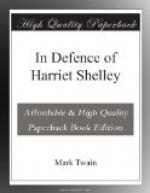Hogg went to the Godwin residence in Skinner Street with Shelley on that 8th of June. They passed through Godwin’s little debt-factory of a book-shop and went up-stairs hunting for the proprietor. Nobody there. Shelley strode about the room impatiently, making its crazy floor quake under him. Then a door “was partially and softly opened. A thrilling voice called ‘Shelley!’ A thrilling voice answered, ‘Mary!’ And he darted out of the room like an arrow from the bow of the far-shooting King. A very young female, fair and fair-haired, pale, indeed, and with a piercing look, wearing a frock of tartan, an unusual dress in London at that time, had called him out of the room.”
This is Mary Godwin, as described by Hogg. The thrill of the voices shows that the love of Shelley and Mary was already upward of a fortnight old; therefore it had been born within the month of May—born while Harriet was still trying to get her poem by heart, we think. I must not be asked how I know so much about that thrill; it is my secret. The biographer and I have private ways of finding out things when it is necessary to find them out and the customary methods fail.
Shelley left London that day, and was gone ten days. The biographer conjectures that he spent this interval with Harriet in Bath. It would be just like him. To the end of his days he liked to be in love with two women at once. He was more in love with Miss Hitchener when he married Harriet than he was with Harriet, and told the lady so with simple and unostentatious candor. He was more in love with Cornelia than he was with Harriet in the end of 1813 and the beginning of 1814, yet he supplied both of them with love poems of an equal temperature meantime; he loved Mary and Harriet in June, and while getting ready to run off with the one, it is conjectured that he put in his odd time trying to get reconciled to the other; by-and-by, while still in love with Mary, he will make love to her half-sister by marriage, adoption, and the visitation of God, through the medium of clandestine letters, and she will answer with letters that are for no eye but his own.
When Shelley encountered Mary Godwin he was looking around for another paradise. He had, tastes of his own, and there were features about the Godwin establishment that strongly recommended it. Godwin was an advanced thinker and an able writer. One of his romances is still read, but his philosophical works, once so esteemed, are out of vogue now; their authority was already declining when Shelley made his acquaintance —that is, it was declining with the public, but not with Shelley. They had been his moral and political Bible, and they were that yet. Shelley the infidel would himself have claimed to be less a work of God than a work of Godwin. Godwin’s philosophies had formed his mind and interwoven themselves into it and become a part of its texture; he regarded himself as Godwin’s spiritual son. Godwin was not without self-appreciation;




